Swedish Masters in IT
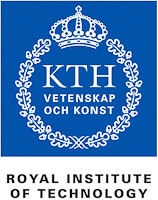 I think no one will dare to challenge the axiom that education is useful. Its benefits are especially significant in the field of technical sciences. Each techie has his own way: some get knowledge at the university, others prefer to study at work, gaining practical skills and gaining experience, while others are engaged in self-education. At different times, I tried different options and, in the end, noted for myself that I like to study. The process of acquiring new knowledge gives me pleasure. As an addict is drawn to a new dose, so am I drawn to new knowledge. And this craving led to the fact that one morning I woke up as a student at a Swedish university. I looked around, got used to the new situation and I hasten to share my observations with Habr.
I think no one will dare to challenge the axiom that education is useful. Its benefits are especially significant in the field of technical sciences. Each techie has his own way: some get knowledge at the university, others prefer to study at work, gaining practical skills and gaining experience, while others are engaged in self-education. At different times, I tried different options and, in the end, noted for myself that I like to study. The process of acquiring new knowledge gives me pleasure. As an addict is drawn to a new dose, so am I drawn to new knowledge. And this craving led to the fact that one morning I woke up as a student at a Swedish university. I looked around, got used to the new situation and I hasten to share my observations with Habr. So Royal Technology University of Sweden ( Kungliga Tekniska högskolan, KTH). It was founded in the 19th century and is one of the leading technical universities in Scandinavia. In the world ranking is located at number 148 . A good position, given that my previous university held an honorable 2994 place. My master's program is called Communication systems . Various types of computer networks, mobile communications, network security as well as entrepreneurship in the field of ICT - all this is included in the program. Training is fully in English.
Joining KTH is a separate story. It was a year-long path and someday, perhaps, I will describe it separately. Now I just note that the stage of admission can end in different ways. In the ideal case, the student will be given the opportunity to study for free, monthly receive a scholarship and rent university housing for reasonable money.
University infrastructure and equipment
KTH includes several campuses within Stockholm, the main of which is KTH Main Campus. The main campus looks impressive, reminiscent of the old British universities in architectural style: massive red brick walls, cobblestone road, ivy.


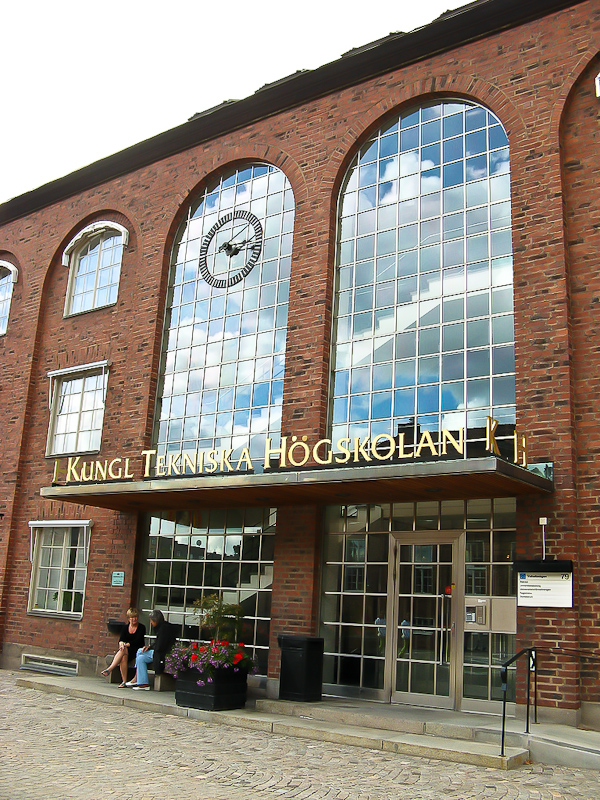
But IT professionals do not observe this beauty, because they study for the most part not on the main campus, but on the northwest Kista campus. The buildings of the Kista campus were inherited by IBM from the university, so they are technologically advanced both inside and out.

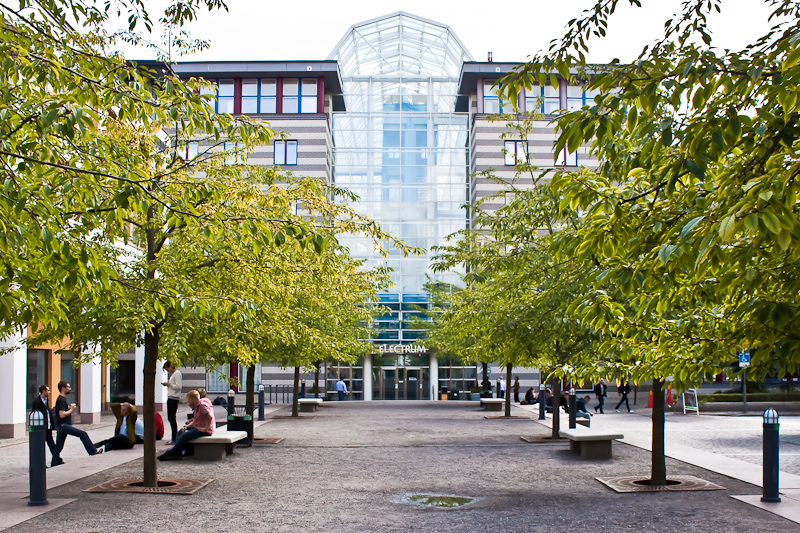
On campus buildings, an electronic room admission system has been deployed. I think in our time, and especially in Sweden, you won’t surprise anyone with the presence of such a system.


Each student has a magnetic card with a photograph. A PIN code is attached to the card.
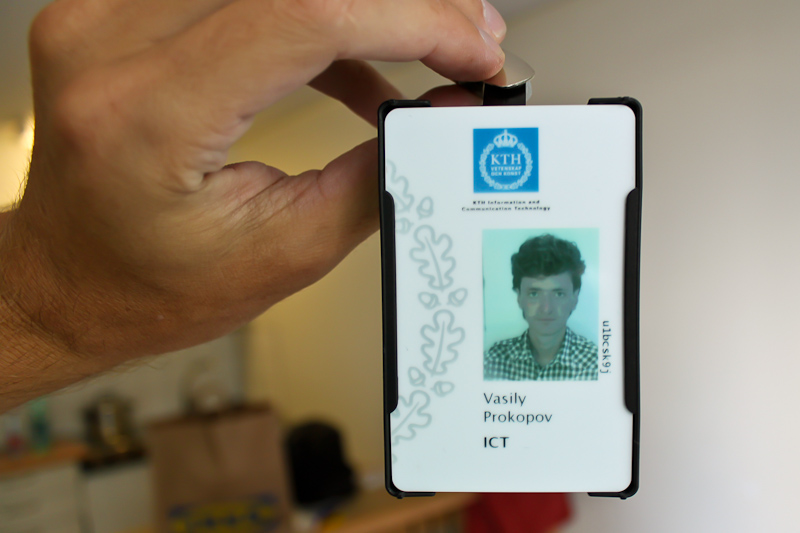
Using this card and code, you can access various rooms, such as computer classes, rooms with printers, or self-study rooms. Students do not have free access to some parts of the building. But in this case, a telephone is always installed to contact the right person on the other side of the closed door.
Separately, I want to note the care of the disabled. You can get to any point of the university building in a wheelchair thanks to ramps, elevators and wide doorways. One of our lecturers is experiencing problems with movement after the accident (pah-pah, he needs a speedy recovery - a good guy). So, he does not feel any restrictions and looks quite happy driving around the campus on his Segway.

Lecture halls are equipped with projectors and professional lighting equipment. There is also sound equipment, and if there are many listeners, the lecturer uses a wireless microphone.
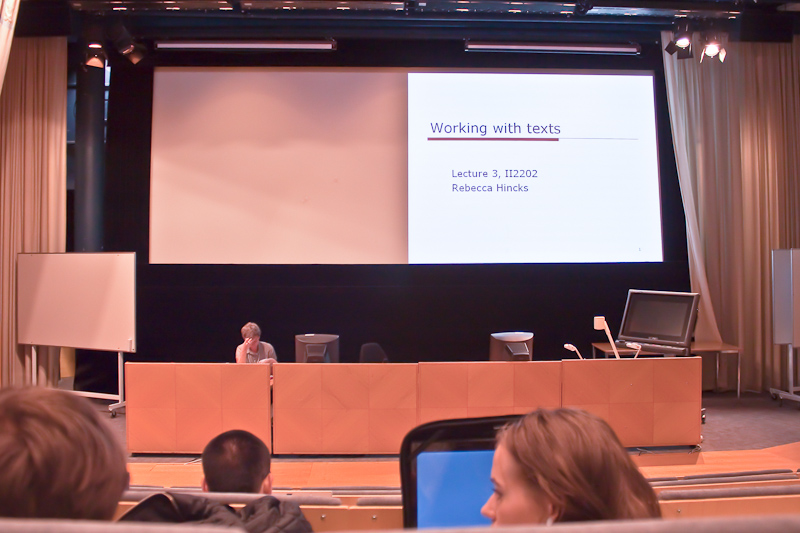

The seminar rooms have interactive whiteboards. They work like large monitors and respond to touch.

In the laboratory rooms you can find various equipment. On our program, we usually deal with network equipment Cisco, Juniper, HP. These devices were received by the university through partnership agreements with manufacturers. This, of course, is not about advanced lines. However, the devices provide all the basic functionality, starting with support for dynamic routing protocols and ending with MPLS technology.

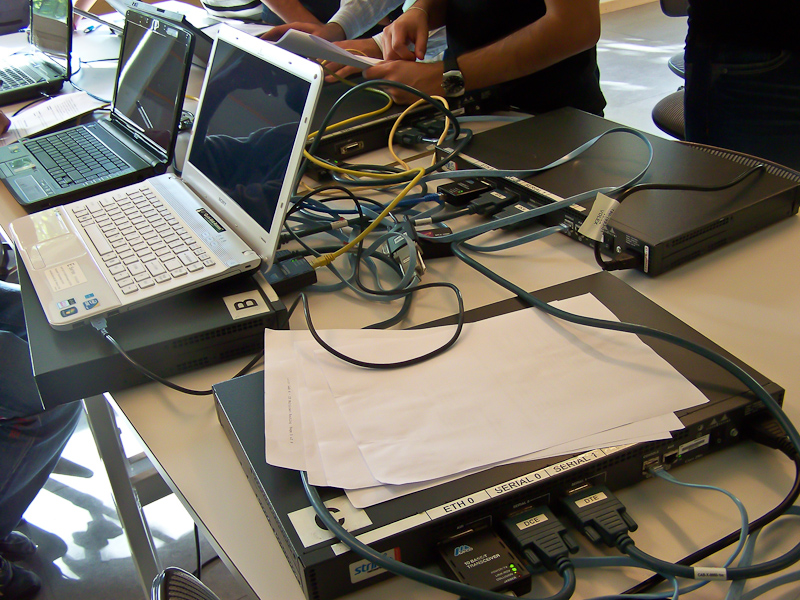
As for self-study rooms, there are a great many of them. They are located throughout the campus and are available almost around the clock. Nearby is usually a kitchen with all the associated arsenal. You can have a snack right on the spot. Reservation of rooms is necessary through the university electronic system. If you didn’t manage to book a room in advance, which happens quite often, then you can stay in any corridor.

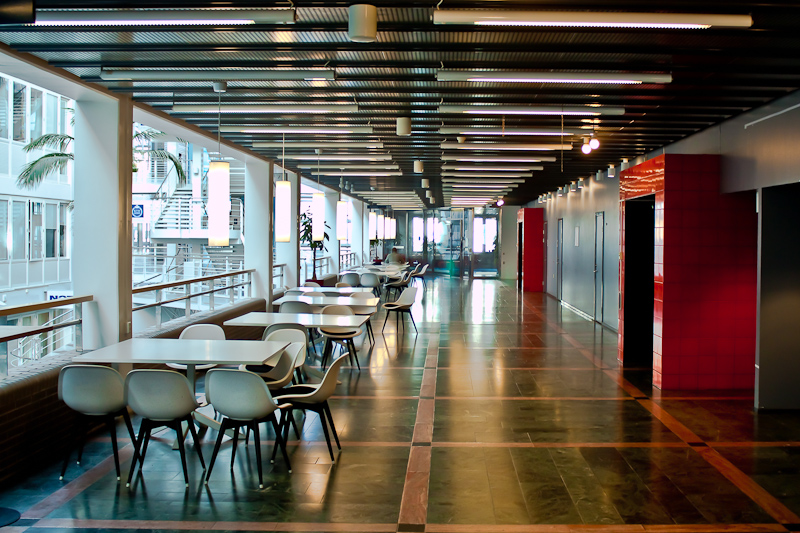
With a 90 percent probability, there will be a power outlet and a jack for connecting to the university network nearby on the floor. But you can do without wires: the entire campus is covered by a wireless Wi-Fi network with Internet access. There are no problems with the network in general in Sweden. At home, students usually have 100 megabits of channels with no traffic restrictions.
The university has a dining room. Not only students eat here, but also employees of nearby Ericsson offices and other IT companies. Lunch, taking into account the student discount, will cost 7 euros.


All these amenities are created with one goal in mind - to make the student enjoy learning. However, university infrastructure alone is not enough. The correct organization of the learning process itself is also important. Now I will tell you how it works with the Swedes.
Organization of the educational process
The academic year is divided into 2 semesters - autumn and spring. Each semester, in turn, consists of 2 periods. Thus, we have 4 periods in the school year. The first period starts in late August and ends with exams in October. The second, third and fourth periods follow each other until the end of May. During each period, the student studies a limited number of subjects (courses) - usually 2-3, not more. Courses can be chosen as you wish. There are a number of required courses that you must attend in any case. Differences from our education system are observed, when for six months we studied 5-8 subjects and closer to the end chaos began in attempts to grasp the immensity and pass all the exams.
In the Western system, it’s simpler - at one time you focus on a limited number of subjects and have the opportunity to study them more deeply. In my opinion, the described system has the following advantages:
- Students do not play the fool. Only 2 months are allocated for the course, so you need to work from the very beginning, otherwise you just will not have time to cope with all the tasks
- Teachers keep their finger on the pulse. Control points (exams, presentations, reports) are located densely over the entire course
- The student makes a decision about which courses to listen to every 2 months, which allows him to adjust the trajectory of movement as part of the master's program. You study, for example, Wireless networks. I did not like it - in the next period you change the track to Technology-based entrepreneurship.
What does the course consist of? If the course is technical, such as Advanced Internetworks, you will most likely have to deal with labs, a project, and an exam. Lectures will also be, but usually their attendance is not compulsory, unlike laboratory and examinations (who would doubt it). However, most students attend lectures. The reason for this is bright, interesting and experienced teachers. Not all, of course. Sometimes it happens to have a “dead” lecturer. But even then the situation is not hopeless, because usually one person does not read all the lectures. It is common practice to invite so-called “guest” lecturers from other universities or people from the industry. For example, Stina Ehrensvärd, CEO of Yubico, a multi-factor authentication solutions company, recently shared her entrepreneurial experience.
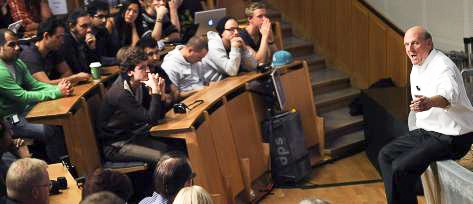
Nobel laureate in physics Konastantin Novoselov told us about graphene.

If we talk about good lecturers, then first of all I note the American professors. There are a lot of them in KTH and from their lectures they make representations. Most of all I remember the professor who worked most of his career at HP Labs in America. He was very exciting and with a huge number of examples from personal practice spoke about the stages of creating an IT product. It was also interesting to learn firsthand how some time ago the HP team disassembled the Palm PDA screw to identify the components and understand why the competitor jumped them. HP reverse engineering.
In addition to lectures, almost every course involves a small project carried out by a group of students from 3 to 15 people. The team includes people from different cultures. Not everyone has group work skills and technical experience. For these reasons, working with them is often not easy. According to my observations, the role of leaders in a team is more often taken by Europeans. Asians prefer to perform specific tasks set by leaders. Teamwork is always difficult, but ultimately has a positive effect in the form of new acquaintances and experiences.


The task of the most interesting project in my practice was to develop an IT product that recognizes human emotions. In 2 months it was necessary to go from an idea to a working prototype. The students proposed various options: from a chain around his neck, which is able to assess a person’s emotional state and, accordingly, update his Facebook status, to a device that monitors a child’s emotional state and alerts parents in case of danger. Our team presented the prototype of the latter at the final presentation. Here's what it looked like:
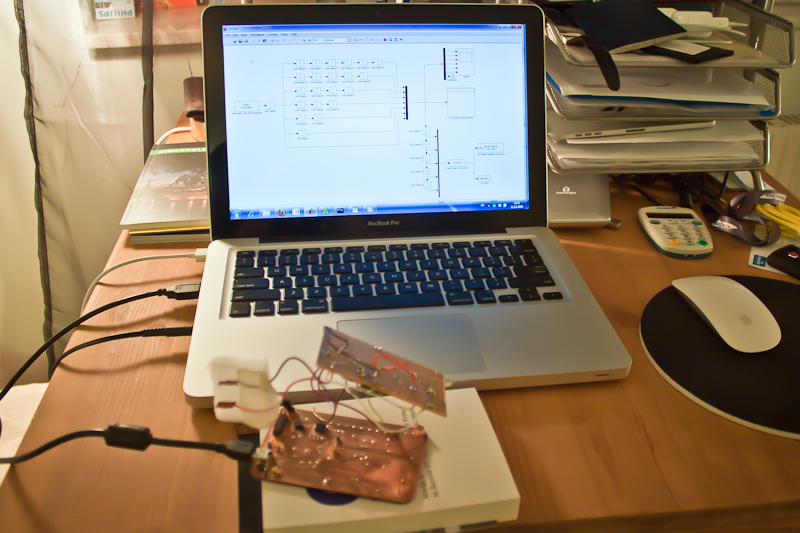

The team is in the process of working on this technical masterpiece.
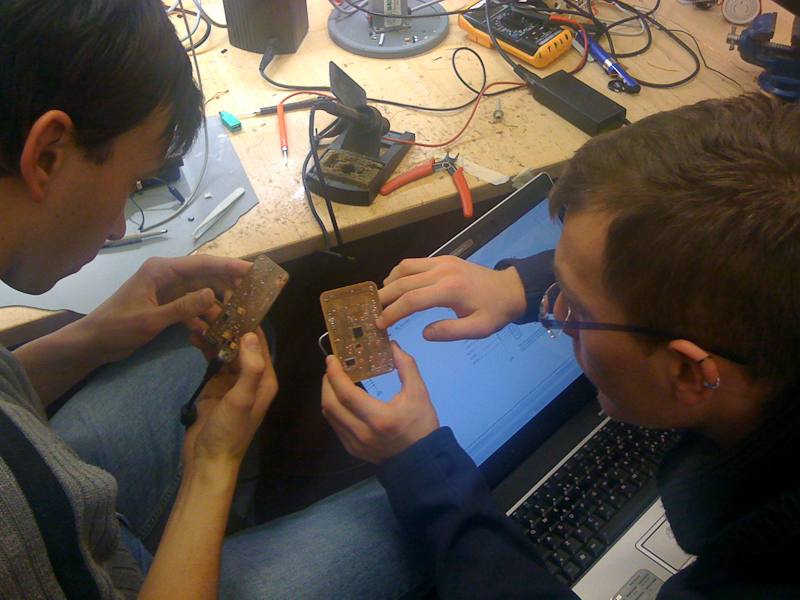
Further, what are laboratory ones? In this part, the difference from our universities is minimal. Usually it comes down to setting up the equipment in a small network topology. For example, a job requires you to configure MPLS including Traffic Engineering on Juniper devices. For admission to the lab, you must pass an online test of a dozen questions. You don’t need to write a report, just support the conversation with the teacher and answer his questions during the laboratory.
We came to the most interesting thing - the exam. It lasts 4 hours. The electronic system randomly selects an audience and a place in this audience for each student. Chance to sit next to an excellent pupil of Liao and he practically has nothing to write off. Yes, and it’s dangerous to write off: KTH adopted a policy of “zero tolerance” for deceivers. Near each exam room there is a list with the names of students.

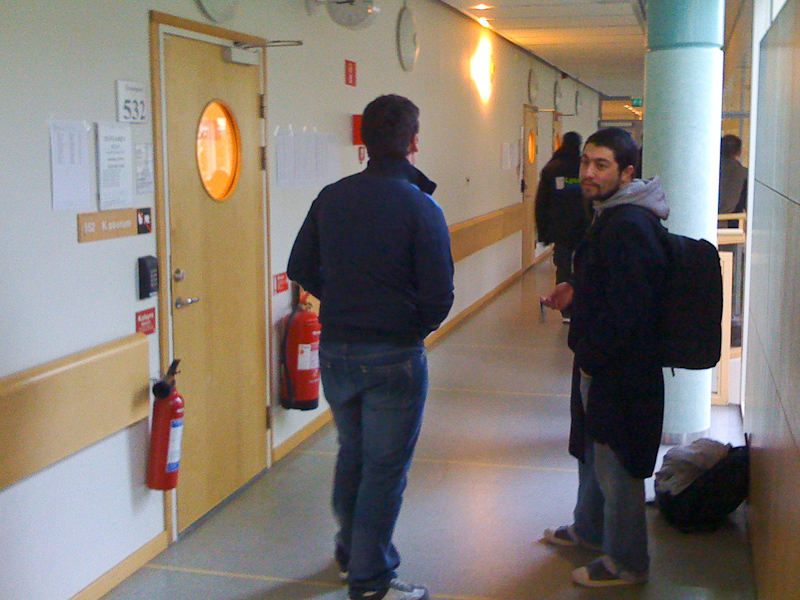
Phones and personal items are usually stored in a specific place. You can take a pen or pencil with you at the table. For your creations they will be given special paper with a coat of arms, writing is allowed only on it. The exam itself usually consists of two parts (now we are talking about a technical exam). The first part suggests choosing the right answers to a series of short questions. If in this part the student does not gain the minimum required number of points, for example 15 out of 20, then the exam fails. The second part in this case is not even watched. If the student has crossed the threshold in the first part, then the second part is evaluated, which usually consists of 3-5 more difficult questions in comparison with the first part. It is necessary to answer the questions of the second part in detail; no answers are proposed here. The amount of points scored in both parts determines the score.assignments for the course “Internet security and privacy”.
During the exam, the teachers responsible for the course come into the audience several times and answer students' questions. The “overseer” is constantly present in the audience, but he usually has nothing to do with the course. If something is not clear in the task, asking the “overseer” about this does not make sense.
Sometimes, due to some circumstances (usually not depending on the student;), it is not possible to competently go all the way and the student fills the lab, project or exam. In this case, there is only one way out - to pack your suitcase and return home ... Just kidding, you can always fix the situation. The rules are very liberal:
- Didn't complete the lab? It doesn’t matter, at the end of the period there is one additional “make-up” session, within which you can execute any of the missed labs. But only once, and only once. If there are more debts on the labs, the train has left, the course will not be counted.
- Did you fail the exam? Trivia, at the end of the semester, time is allocated for retake.
- Got a low rating and think you deserve more? Again, welcome to the retake. You can try at least every time a course is taught (usually once a year). Ultimately, the best of the grades received will go to the diploma.

Most of all I like the non-linearity of the AF rating scale. Low grades are easy to obtain, while as you move towards A, the requirements for the candidate increase exponentially. Therefore, it is not easy to become an excellent student here. A truly outstanding mind will be at the highest level, while in the homeland both genius and just a clever lucky guy could become an excellent student.
On this, perhaps, let me draw a line.
The description concerned only the academic part of my life in Sweden. I tried to save the text in the Habr format, so friends and parties were left out of brackets.
